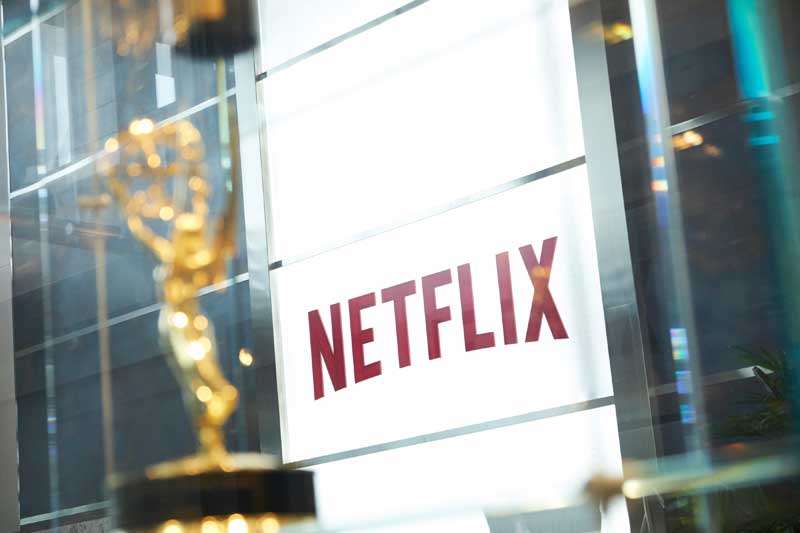Through the looking glass of doom
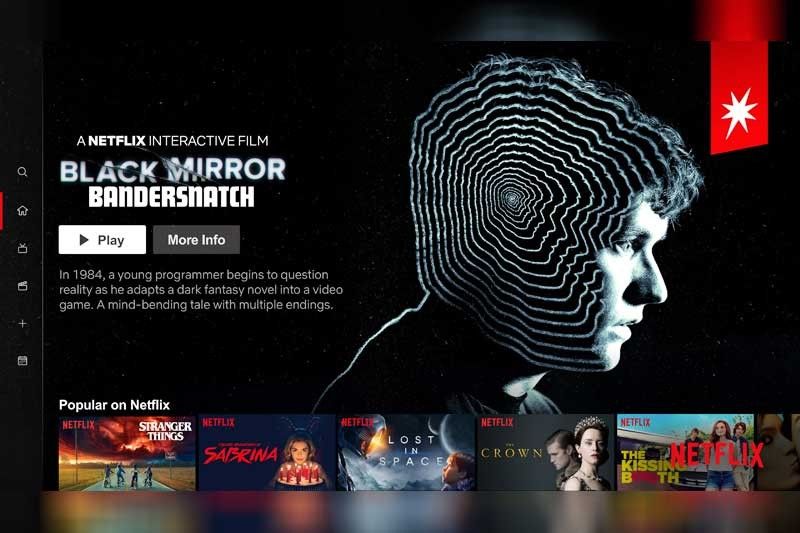
Watching ‘Bandersnatch’ — with five main endings and multiple variants — is an experience that promises to be different for each viewer. ‘Black Mirror’ creator Charlie Brooker says, ‘It’s all a bit like a bloody Rubik’s Cube!’ Or a hi-tech ‘Rashomon.’
Netflix Presents Groundbreaking ‘Black Mirror: Bandersnatch’
Prologue: Inside an old Mediterranean-style hotel in Los Gatos, California — with some Blue Moon beer, chips, infinite channels of American TV (one was showing the backwards episode of Seinfeld set in India) — a quiet night in was disrupted by a phone call from an airline. “Are you near the airport, sir?” a woman asked. “Er, no,” I said, as Pinter and the heir to the Oh Henry! candy bar fortune were about to get married. “Your flight to Manila is ready to board in 30 minutes!” Time stopped seemingly; a star fell, a snowball thrown. Every detail of my trip was jotted down on my mobile phone and iPad; my mind and body simply refused to interpret and absorb the data with dates getting mixed up, words and numbers floating meaninglessly onscreen, today bleeding into tomorrow. A weird disconnect almost worthy of Black Mirror. The airline rep gave me two options: A) gather all my things in the hotel and book a flying Uber, or B) rebook the flight. I had to make a choice.
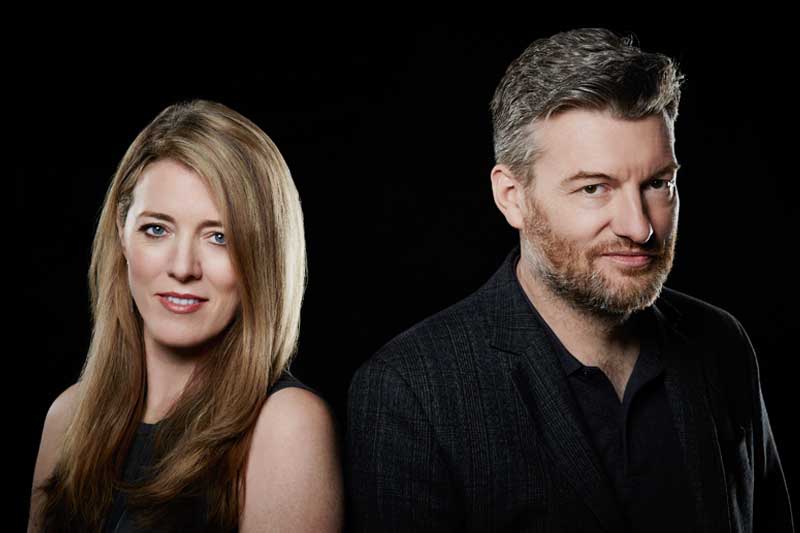
Black Mirror showrunners Annabel Jones and Charlie Brooker
* * *
Which brings us here: Black Mirror: Bandersnatch is now available for streaming on Netflix — and it is an interactive one, a game changer.
Bandersnatch is a Black Mirror Christmas special if you could call it that; it heralds the fifth season of the series created by Charlie Brooker, its third on Netflix after two seasons on UK’s Channel 4. Something unique about this one: this film invites you to demarcate your space, allocate time, and be prepared to be presented with two options at certain choice points (as the show goes on seamlessly, waiting for you to pick one) with the outcome(s) determined by the choices you make.
When I say “choices,” it means you the viewer must actually make the choices for Stefan (a computer programmer played by Fionn Whitehead, who previously appeared on Dunkirk) — via remote control, mouse, or a finger upon a tablet. This is made possible by a groundbreaking program developed by the brilliant minds at Netflix. Remember those Choose Your Own Adventure books of yore such as The Cave of Time, The Mystery of Chimney Rock, Deadwood City, etc.? Well, the same experience is translated into television by Netflix. You as the viewer influence the course of events for the protagonist. You determine his destiny, the outcome of the story(ies). You lead him down the garden of forking paths (please refer to Jorge Luis Borges in your local library), through the sliding doors of possible outcomes and parallel lives (stream that Gwyneth Paltrow movie afterwards), past a memento of objects and wander-land of places along the way (doffs hat to Christopher Nolan and Lewis Carrol), and into that cultural touchstone of “it’s-all-gone-a-bit-Black Mirror” moment where one’s relationship with technology and a hi-tech world is abruptly soured by the strange, the bizarre, the unexpected, with everything arriving with a nifty White Bear logo or a derp emoji.
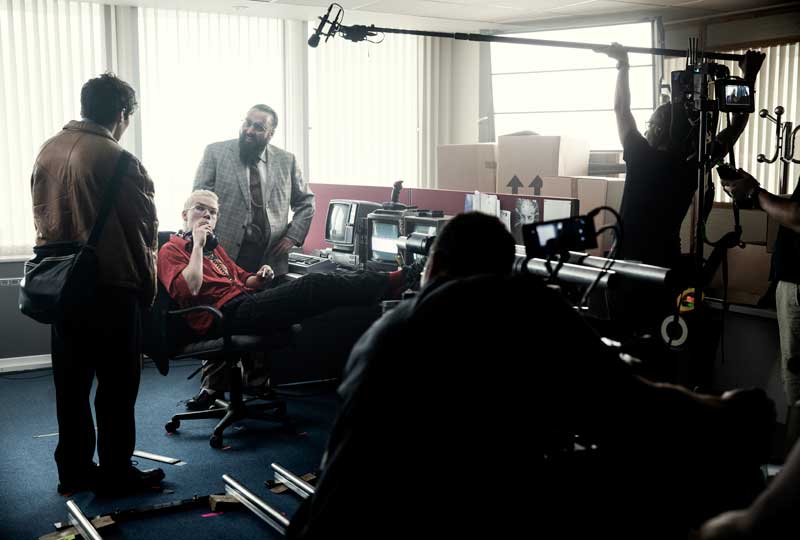
On the set of the latest Black Mirror film: 312 minutes of footage was reportedly shot for it.
The choices start off un-alarmingly, seemingly innocuous at first for Stefan: what cereal to eat, whether to listen to the Thompson Twins or something else, this being Britain in the ’80s with its palette of gray council flats and New Romantics neon. But once Stefan attempts to develop a choose-your-own-adventure fantasy novel into a video game based on a book by Jerome F. Davies, chaos ensues accordingly. Reality and the virtual world get mixed into a one headf*ck of a Gordian-knotted, Ariadne-threaded cocktail soundtracked by “Phaedra” or the other. Life takes a turn for the fairly odd and labyrinthine. The choices become more and more morally compromising. Should Stefan accept the job at a video game company called Tuckersoft or not. Should he reveal everything to his therapist or clam up. Should he follow Colin (played by Will Poulter) down the rabbit hole. It is like groundhog Frankie setting off for Hollywood but ending up on the Yellow Brick Road. (“Relax, don’t do it!”)
It’s choose-your-own-misadventure, so to speak: the statisticians at Netflix tell us that there are five main endings of Bandersnatch with unique permutations or variations charting to more than a trillion. Worry not, this doesn’t mean there are actually a trillion unique paths or storylines, though. But I am sure viewers will be watching and re-watching Bandersnatch on the hunt for Easter eggs, new scenarios, surprise endings.
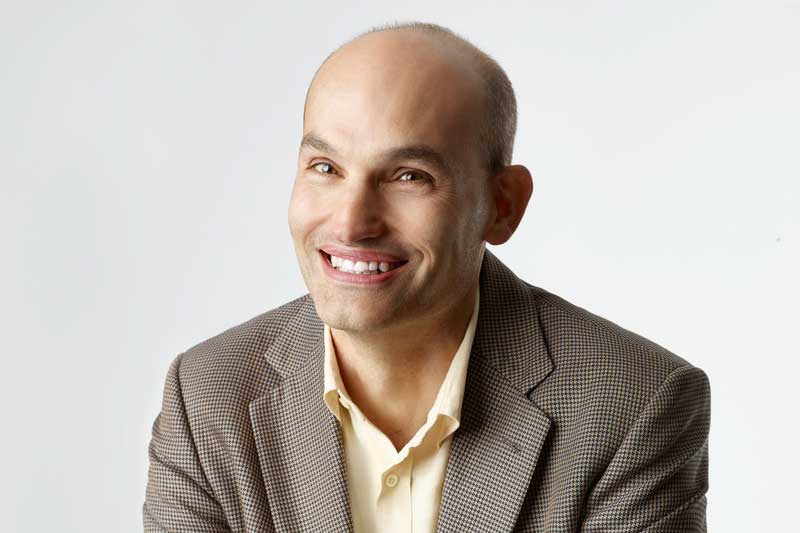
Netflix vice president of product Todd Yellin. Yellin explained, “Trying to put together something that’s unique like Bandersnatch doesn’t just take content and great storytelling. It doesn’t just take technology and design. It takes both.”
Netflix (through our friends at Netflix Asia Pacific and Ad Pub Hub) invited The Philippine STAR along with other media outlets such as Wired magazine and The New York Times to the Netflix headquarters in Los Gatos, California at the tail end of November for a hush-hush preview of Bandersnatch. We were herded into the Kabuki Theater, handed an iPad each, and were given roughly one-and-a-half hours to watch Bandersnatch and be in control of Stefan’s journey into the heart of coded darkness. After which, we talked among ourselves at the stacked Netflix commissary as to what ending(s) we encountered. How was your ashtray moment? Did you drop acid? What’s on that Betamax tape?
There were also roundtable discussions with Netflix vice president of product Todd Yellin and director of product innovation Carla Engelbrecht as well as Bandersnatch director David Slade (who also directed the ballsy, shot in black-and-white Metalhead) and series producer Russell McLean; plus, a one-on-two interview with Black Mirror showrunners Annabel Jones and the great Charlie Brooker himself. (More about Brooker’s bleak worldview in a future article.)

Netflix director of product innovation Carla Engelbrecht. Carla explains, “You could say all the great stories have been told and all the great films have been shot. We (at Netflix) keep finding ways to break the forms of storytelling and involve viewers.”
“Black Mirror means so many things to so many different people,” said Peter Friedlander, Netflix Original Series vice president. Friedlander is in charge of drama programming — from Narcos to Mindhunter, from Godless to Black Mirror.
“Some may say it is an exploration of theories of techno-paranoia in contemporary times, but it, every episode is different, every film is so unique whether it’s an ’80s romance like San Junipero, or a workplace slash space caper of USS Callister, they’re all so unique. But when you watch them, you often ask yourself: (how about) the next one, what’s it going to be like? How are they going to raise the bar? What’s the next level? And we think that is Bandersnatch.”
You simply don’t get to relax when watching a Black Mirror episode, remarked Todd Yellin. Yellin oversees the product experience in the Northern California HQ. “Believe me with Bandersnatch it’ll be the same. It’s exciting and it’s unsettling. So why did we put in so much effort from a technology and a storytelling perspective to create an interactive film? The reason is, we want to really take storytelling to the next level. And part of that is creating a more visceral experience for the viewer, making (him or her) more complicit in what the main character is doing. So, when you see the consequences of what happens with those choices, you as the viewer feel partially responsible. The stakes have become much higher.”
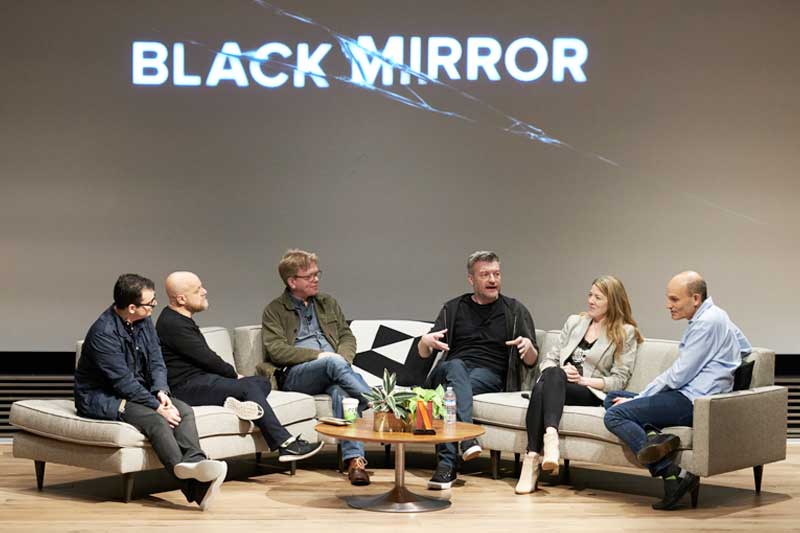
Fireside chat: Writer Charlie Brooker talks about how everyone had a moment of vertigo during the creation of Bandersnatch and its choose-your-own-adventure format. With Brooker are (from left) Netflix director of Original Series Andy Weil, David Slade, Black Mirror series producer Russell McLean, Annabel Jones and Todd Yellin.
Yellin described brainstorming with Charlie Brooker as like letting a rhinoceros loose inside a room. Well, if the rhino dabbled in video games, lamented about the dawn of the dumb, and griped about how TV ruined its life. The Netflix executive recalled how Charlie and Annabel were a bit reluctant at first when broached the idea for an interactive film. (Netflix had already done it in kiddie titles like Minecraft: Story Mode, Stretch Armstrong, and Puss in Book: Trapped in an Epic Tale although with much simpler branching narratives: a kiss or a handshake, to fight a god or a tree, sort of stuff.) Brooker would say later on that he initially found it gimmicky and feared that the whole experience would be as clunky as popping in a CD-ROM. But a few weeks later back in the UK, Charlie and Annabel were throwing ideas around and they hit upon a story that could only work interactively. The two excitedly got back on the phone with Netflix, Charlie was reeling with ideas like mad and was using a program called Twine to do an outline of the story.
Brooker explained, “I had to learn the programming language, because I didn’t know that it was going to be that complicated, I thought it would just be a flowchart and I could do it on a bit of graph paper. And I’d send emails back and forth and I’d be asking questions of the (Netflix) team here — and the answer was never, ‘No, you can’t do that.’ It was was either, ‘Yes, you can,’ or ‘We don’t know, but we think..’ and then they’d come back and sort of say, ‘Yup, that’s achievable.’” (A member of Netflix’s brain trust would characterize this process as “building the plane as we fly it.”) Brooker shared, “And so then you’d be like, ‘Sh*t, now I’ve got to do that.’ And so the story kept expanding and expanding — and it was like whole new islands started appearing.” Islands, more islands and a few more existential islets.
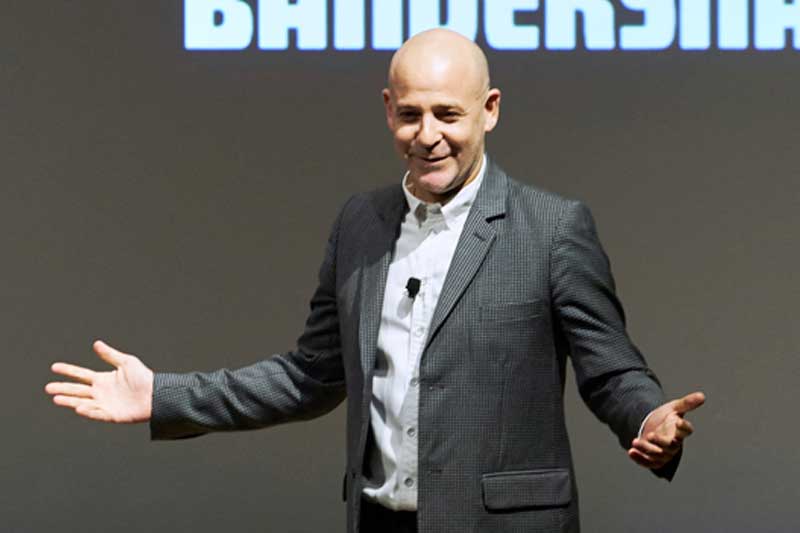
Peter Friedlander, Netflix vice president of Original Series.
It did not turn into a clump of dreadlocked, dead-end narratives, though, thanks to a digital program developed by Netflix which made Brooker’s life easier: Branch Manager.
Carla Engelbrecht explained, “This tool works for everything from outline and pre-visualization through delivery to Netflix.” Carla’s focus is on interaction originals, the network’s interactive content. She said, “So in the case of Charlie, by using this tool, it meant that he could tell a story that looks like this. This is Bandersnatch.” Engelbrecht then showed us an indecipherable graph of intersecting lines representing forking paths and crosscutting plotlines. It would probably take a bunch of monks working round the clock to make sense of anything. For a month. On speed. Maybe dial-a-friend in the form of Simon Magus operating HAL 9000.
“No human can do this with pencil and paper. (Laughing) Or I would love to meet the human who can. What Charlie did was beyond our wildest imagination. He told a brilliant, amazing story. He used our tools in ways that we didn’t know was possible.”
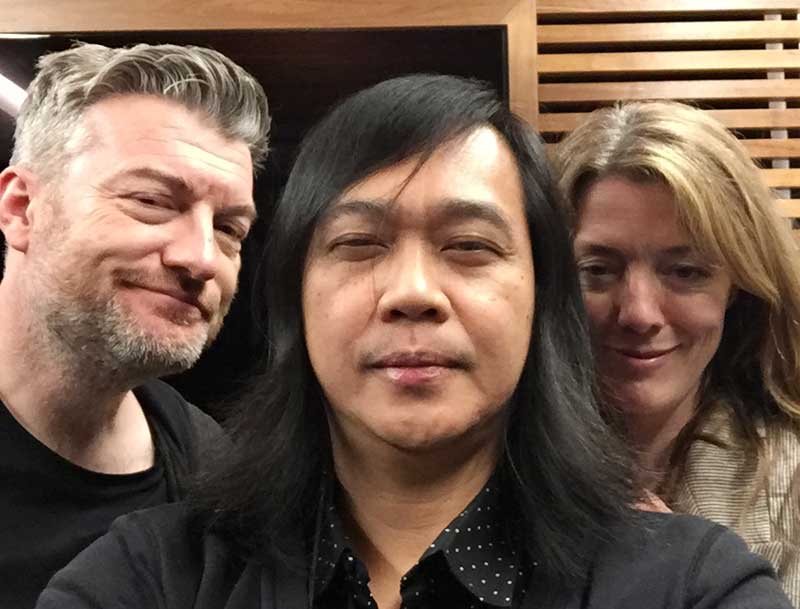
The author Igan D’Bayan with Charlie Brooker and Annabel Jones at the Netflix HQ in Los Gatos, California.
In the past, both Brooker and Jones have toyed with the idea of adding alternative endings to some of their films. White Bear, for instance. Another was Play Test. Charlie explained, “I remember at one point pitching the idea of a nightmare mode (just like in video games) — so if you’d watched Play Test, and if you’d then watched it a second time, it had a different ending because I really liked the idea of people freaking out, thinking they were being randomizing or something. But, I guess none of those things were actually interactive so much as they were things that could only happen in a way we could deliver something — in a sort of nonlinear way.” But Bandersnatch clearly is on another level altogether.
“It’s a beast,” Annabel described.
“It’s a bastard!” cracked Charlie.
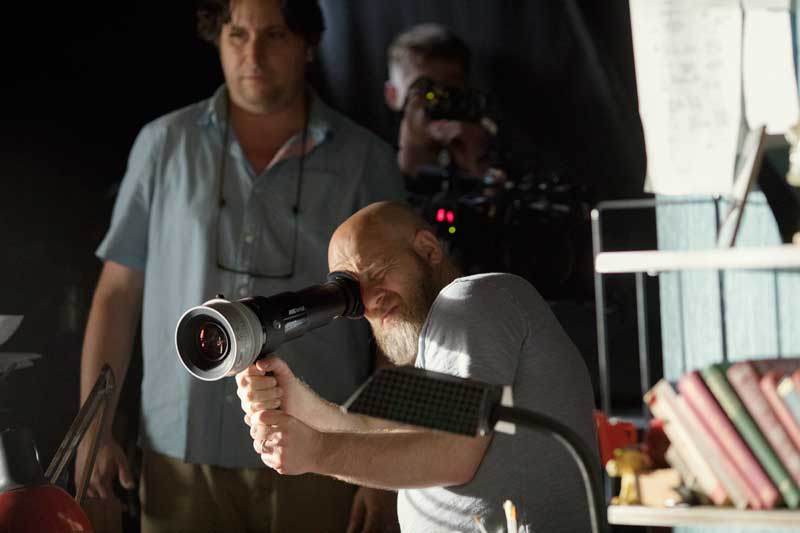
Bandersnatch director David Slade, who also directed Metalhead from Season 4 of Black Mirror. Slade says, “The first time we had a paper script, it took four hours to read it. I don’t want to start making a film until I have the entire movie in my head — you couldn’t do that (with Bandersnatch). It was a constant process of becoming.”
Annabel said, “Netflix has this huge platform. It has this tool, this opportunity to take its films and add a new layer, a new level of engagement. But you only use it if you feel you’re adding something to the story rather than detracting from it. I think in the world we’ve created, once you’ve had the whole experience, you would understand the reason we used it.”
She explained that it was very important to create a cohesive universe and consistency of character, otherwise there would be no emotional engagement. “This idea of freedom of choice and illusion of choice, of control and the illusion of control.. Once you’ve got them as a basic conceit, and you have a protagonist whom you can give multiple endings, with those endings only reinforcing the whole, then that’s delicious.”
Charlie said, “This is the weirdest film we’ve done by quite a long shot — because it breaks the fourth wall in places, it’s very meta, it’s very experimental. But we’ve sort of embraced that while doing it. It’s all a bit like a bloody Rubik’s Cube: the experience would be different for different people.”
The man who wrote the Emmy Award-winning San Junipero, the surprisingly prophetic The National Anthem and fan favorite White Christmas, described the essence of what makes Bandersnatch an essential watch:
“It’s quite nuts.”
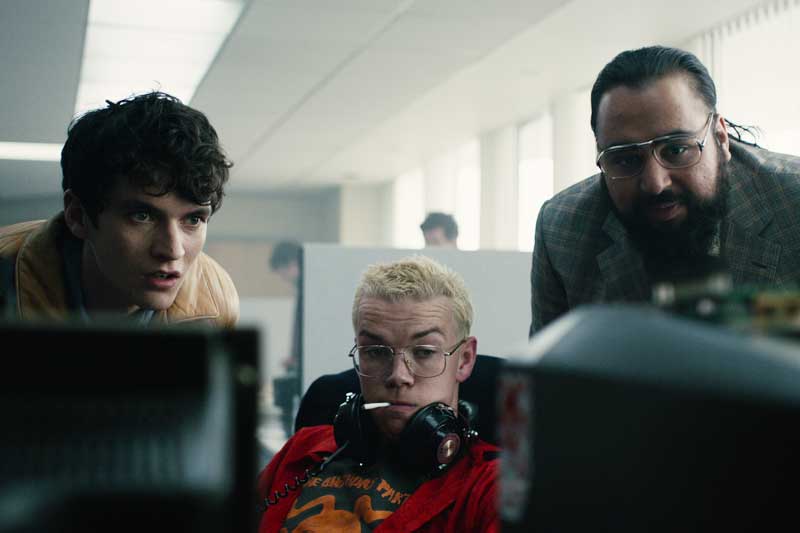
And the abyss stares back: Stefan (Fionn Whitehead), Colin (Will Poulter) and Tucker (Asim Chaudhry) in a scene from Bandersnatch.
* * *
Epilogue: On the last day of the press trip, we journalists hung out at Nick’s Next Door with Todd and Carla of Netflix as well as Black Mirror producer Russell McLean and Bandersnatch director David Slade. David talked about his love for edgy bands like Tangerine Dream. Russell recalled the time he worked with Tori Amos on her Strange Little Girl music video. (If ever you meet him, ask him about the big black wolf story.) After the last call at Nick’s, one of the Netflix reps suggested we decamp to another joint. We all looked at each other and considered the options: A) go to the bar, or B) go back to the hotel. “Is my flight tomorrow or the day after?” I asked myself. Ah, hell.. Stick us in hyperwarp and let’s.. We walked the streets of Los Gatos. It had been drizzling. The night gleamed with a thousand possibilities.
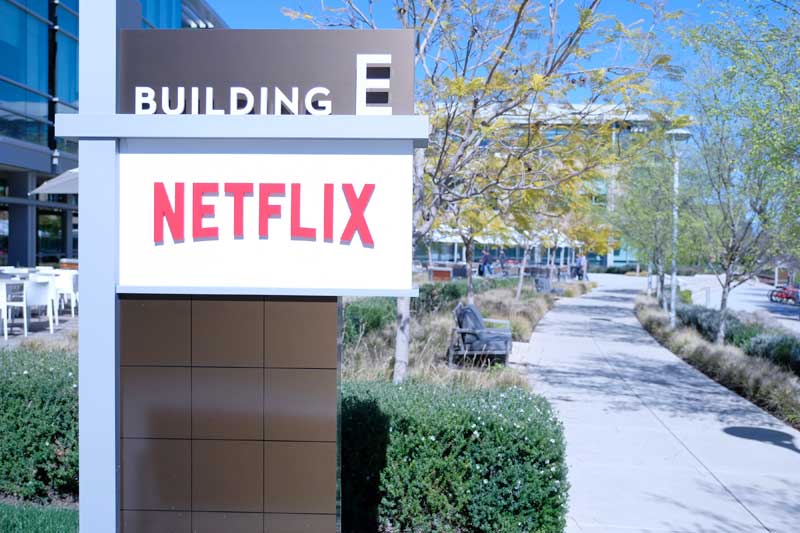
Sorcery central: Netflix headquarters in Los Gatos, California with its Emmys and impressive roster of shows.
* * *
Black Mirror: Bandersnatch is currently streaming on Netflix. It is available across most newer devices, including smart TVs, game consoles, web browsers, as well as Android and iOS devices running the latest version of the Netflix app.
